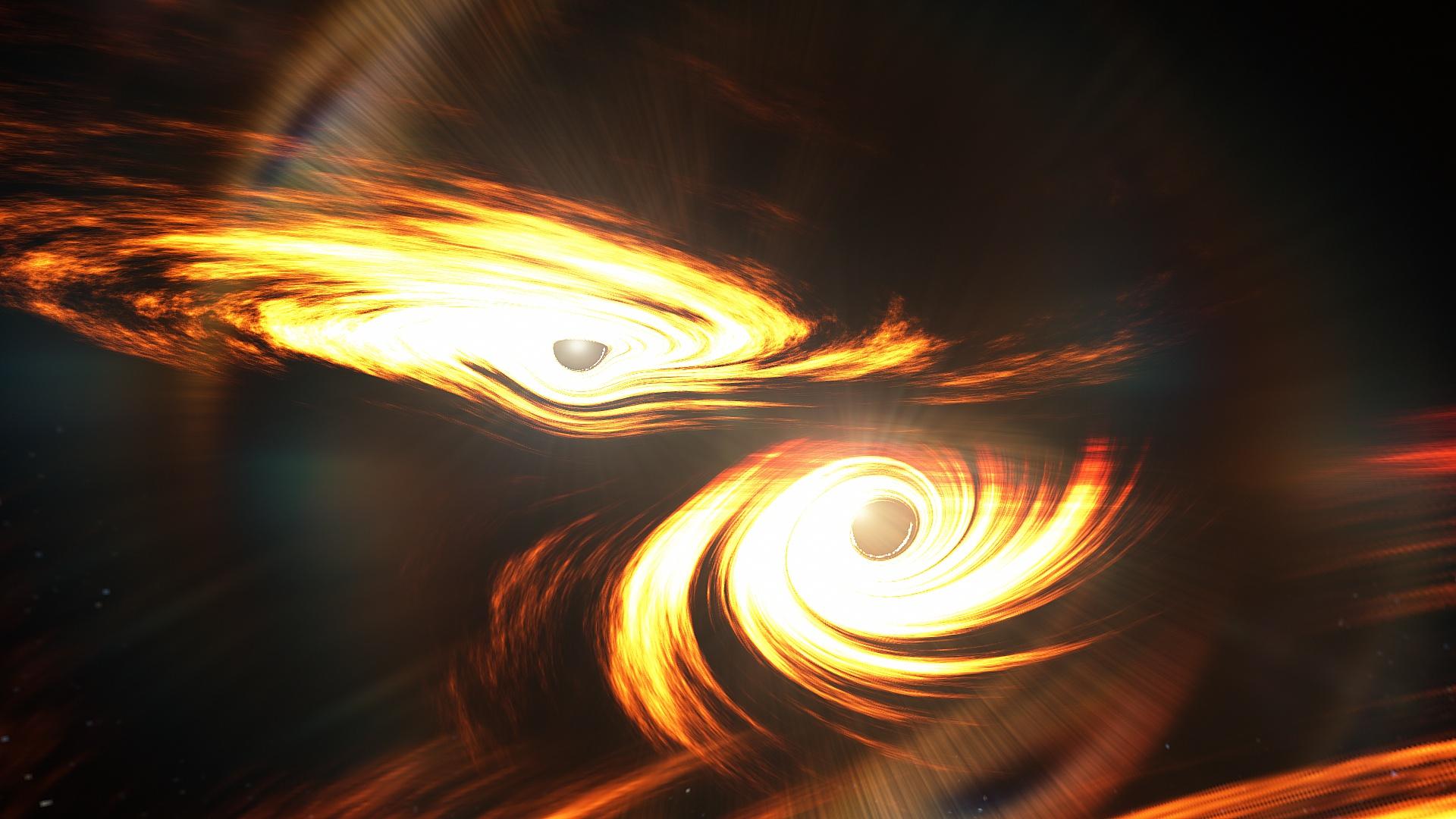First ever detection of monster black hole collision

Artist's impression of binary black holes about to collide by Mark Myers, ARC Centre of Excellence for Gravitational Wave Discovery (OzGrav)
University of Adelaide researchers are part of a team of scientists who have observed the biggest black hole merger so far detected.
Astronomers from the LIGO and Virgo Scientific Collaboration (LVC) have reported the first ever direct observation of two monster black holes which have collided to form an even more massive object: an intermediate-mass black hole, about 150 times heavier than the Sun.
Researchers from the ARC Centre of Excellence for Gravitational Wave Discovery (OzGrav) contributed to the detection and used the computing resources of the new Gravitational Wave Data Centre to infer the masses of the merging black holes.
The University of Adelaide’s Professor David Ottaway, who is OzGrav Chief Investigator and co-author, says: “This is a huge step towards understanding the link between the smaller black holes that have been seen by gravitational wave detectors and the massive black holes that are found in the centre of galaxies.”
The universe was around seven billion years old when these two black holes collided. As the gravitational waves rippled out through the universe, the universe was expanding.
As well as researchers from the University of Adelaide, the team was made up of scientists from Monash University, Swinburne University of Technology, ANU, the University of Western Australia and the University of Melbourne.
Juan Calderón Bustillo co-author and OzGrav postdoctoral researcher at Monash University reports: “This is the first time we’ve observed an intermediate-mass black hole, almost twice as heavy as any other black hole ever observed with gravitational-waves. For this reason, the detected signal is much shorter than those previously observed. In fact, it’s so short that we can barely observe the black hole collision, we can only see its result.”
“This is a huge step towards understanding the link between the smaller black holes that have been seen by gravitational wave detectors and the massive black holes that are found in the centre of galaxies.”Professor David Ottaway
The online detection team at the University of Western Australia detected the event, GW190521, seconds after the gravitational wave data was available, and helped generate public alerts for the LIGO Scientific Collaboration.
OzGrav PhD student and co-author Manoj Kovalam says: “We were among the fastest detection programs to report GW190521. Such a heavy system has never been observed before. It’s exciting to be among the first few to identify it in real-time.
These ‘impossible’ black holes have ‘forbidden’ masses according to what is currently understood about the lives of massive stars.
OzGrav postdoctoral researcher Vaishali Adya from Australian National University explains: “Stars that are massive enough to make black holes this heavy should blow themselves apart in a dramatic ‘pair-instability supernova’. Events like this are now in range due to the improved sensitivity of the instruments compared to the first-generation detectors.”
The rare event has prompted researchers to question how the black hole formed, its origins and how the two black holes found each other in the first place.
OzGrav PhD student and co-author Isobel Romero-Shaw, from Monash University, comments on the perplexing masses: “Black holes form when massive stars die, both exploding in a supernova and imploding at the same time. But, when the star has a core mass in a specific range – between approximately 65 and 135 times the mass of the Sun – it usually just blows itself apart, so there’s no leftover black hole. Because of this, we don’t expect to see black holes in this solar mass range, unless some other mechanism is producing them.”
Since gravitational waves directly measure the masses of the colliding black holes, this measurement should be much more robust than the black hole of a similar mass that was previously reported by Liu et al. (published in the journal Nature last year). That measurement was based on an interpretation of the spectrum of light from the galactic star system LB-1, which has since been refuted. Based on this current study’s mass measurements, researchers found that this kind of black hole couldn’t have formed from a collapsing star—instead, it may have formed from a previous black hole collision.
OzGrav postdoctoral researcher and LVC member Simon Stevenson, from Swinburne University of Technology, says: “These ‘impossibly’ massive black holes may be made of two smaller black holes which previously merged. If true, we have a big black hole made of smaller black holes, with even smaller black holes inside them—like Russian dolls.”
We are witnessing the birth of an intermediate mass black hole: a black hole more than 100 times heavier than the Sun, almost twice as heavy as any black hole previously observed with gravitational waves. These intermediate mass black holes could be the seeds that grow into the supermassive black holes that reside in the centres of galaxies.
Meg Millhouse, OzGrav Postdoctoral researcher and LVC member from the University of Melbourne, was involved in the discovery paper’s analysis. Millhouse says: “We had to use extremely precise and complex models to analyse these heavier black holes compared to previous models used by LIGO for gravitational waves.
Media contacts:
Professor David Ottaway
School of Physical Sciences
The University of Adelaide
Mobile: +61 (0)430 325 099
Email: david.ottaway@adelaide.edu.au
Crispin Savage
Senior Communications and Media Officer
The University of Adelaide
Mobile: +61 (0)481 912 465
Email: crispin.savage@adelaide.edu.au
